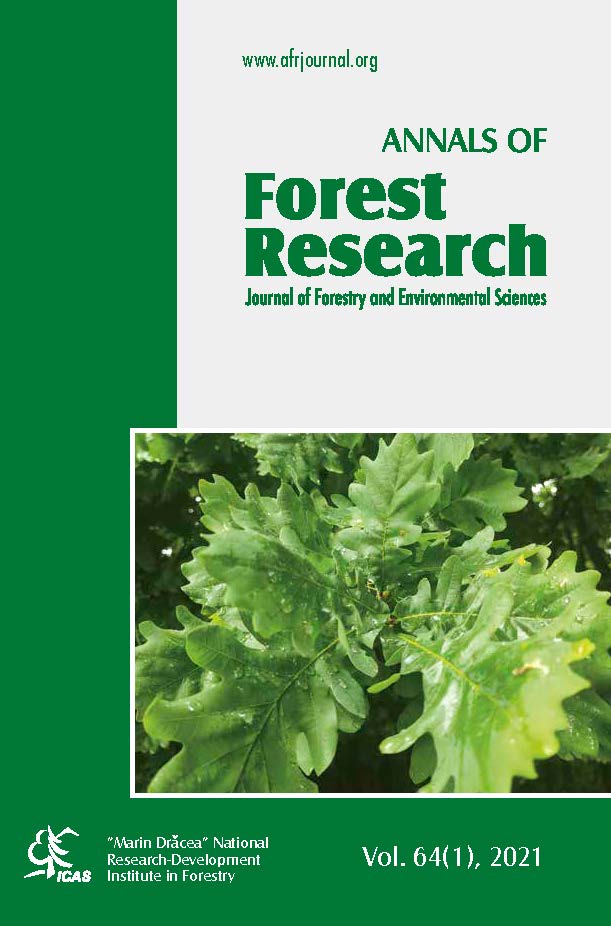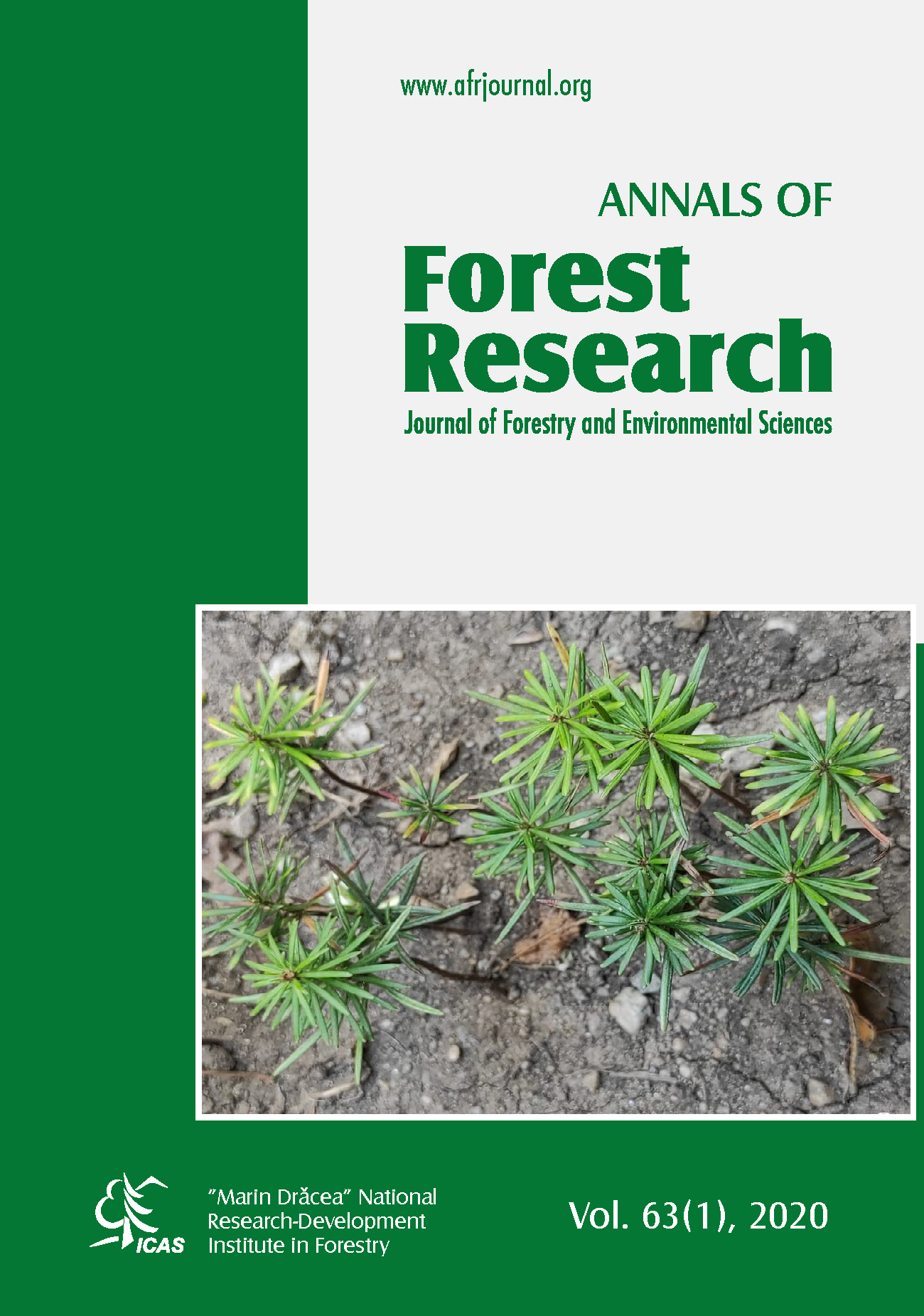Automated detection of individual Juniper tree location and forest cover changes using Google Earth Engine
DOI:
https://doi.org/10.15287/afr.2020.2145Keywords:
NAIP Imagery, Google Erath Engine, Random ForestsAbstract
Tree detection is the first step in the appraisal of a forest, especially when the focus is monitoring the growth of tree canopy. The acquisition of annual very high-resolution aerial images by the National Agriculture Imagery Program (NAIP) and their accessibility through Google Earth Engine (GEE) supports the delineation of tree canopies and change over time in a cost and time-effective manner. The objectives of this study are to develop an automated method to detect the crowns of individual western Juniper (Juniperus occidentalis) trees and to assess the change of forest cover from multispectral 1-meter resolution NAIP images collected from 2009 to 2016, in Oregon, USA. The Normalized Difference Vegetation Index (NDVI), Normalized Difference Water Index (NDWI), and Ratio Vegetation Index (RVI), were calculated from the NAIP images, in addition to the red-green-blue-near infrared bands. To identify the most suitable approach for individual tree crown identification, we created two training datasets: one considering yearly images separately and one merging all images, irrespective of the year. We segmented individual tree crowns using a random forest algorithm implemented in GEE and seven rasters, namely the reflectance of four spectral bands as recorded by the NAIP images (i.e., the red-green-blue-near infrared) and three calculated indices (i.e., NDVI, NDWI, and RVI). We compared the estimated location of the trees, computed as the centroid of the crown, with the visually identified treetops, which were considered as validation locations. We found that tree location errors were smaller when years were analyzed individually than by merging the years. Measurements of completeness (74%), correctness (94%), and mean accuracy detection (82 %) show promising performance of the random forest algorithm in crown delineation, considering that only four original input bands were used for crown segmentation. The change in the calculated crown area for western juniper follows a sinusoidal curve, with a decrease from 2011 to 2012 and an increase from 2012 to 2014. The proposed approach has the potential to estimate individual tree locations and forest cover area dynamics at broad spatial scales using regularly collected airborne imagery with easy-to-implement methods.
References
Bar S., Parida B.R., Pandey A.C., 2020. Landsat-8 and Sentinel-2 based Forest fire burn area mapping using machine learning algorithms on GEE cloud platform over Uttarakhand, Western Himalaya. Remote Sensing Applications: Society and Environment 18:100324. https://doi.org/10.1016/j.rsase.2020.100324
Barboza Castillo E., Turpo Cayo E.Y., de Almeida C.M., et al., 2020. Monitoring Wildfires in the Northeastern Peruvian Amazon Using Landsat-8 and Sentinel-2 Imagery in the GEE Platform. ISPRS International Journal of Geo-Information 9:564. https://doi.org/10.3390/ijgi9100564
Bergseng E., Ørka H.O., Næsset E., Gobakken T., 2015. Assessing forest inventory information obtained from different inventory approaches and remote sensing data sources. Annals of Forest Science 72:33–45. https://doi.org/10.1007/s13595-014-0389-x
Bhandari A.K., Kumar A., Singh G.K., 2012. Feature Extraction using Normalized Difference Vegetation Index (NDVI): A Case Study of Jabalpur City. Procedia Technology 6:612–621. https://doi.org/10.1016/j.protcy.2012.10.074
Boser B.E., Guyon I.M., Vapnik V.N., 1992. A training algorithm for optimal margin classifiers. In: Proceedings of the fifth annual workshop on Computational learning theory. Association for Computing Machinery, Pittsburgh, Pennsylvania, USA, pp 144–152
Breiman L., 2001. Random Forests. Machine Learning 45:5–32. https://doi.org/10.1023/a:1010933404324
Butler R.A., 2009. Google's Earth Engine to help tropical countries monitor forests. In: Mongabay Environmental News. https://news.mongabay.com/2009/12/googles-earth-engine-to-help-tropical-countries-monitor-forests/. Accessed 15 Apr 2020
Chicco D., 2017. Ten quick tips for machine learning in computational biology. BioData Mining 10:35. https://doi.org/10.1186/s13040-017-0155-3
Comber A., Umezaki M., Zhou R., et al., 2012. Using shadows in high-resolution imagery to determine building height. Remote Sensing Letters 3:551–556. https://doi.org/10.1080/01431161.2011.635161
Congalton R.G., 1991. A review of assessing the accuracy of classifications of remotely sensed data. Remote Sensing of Environment 37:35–46. https://doi.org/10.1016/0034-4257(91)90048-B
Cortes C., Vapnik V., 1995. Support-vector networks. Mach Learn 20:273–297. https://doi.org/10.1007/BF00994018
Earth Observing System, 2020. NAIP (National Agriculture Imagery Program) [WWW Document]. Earth Obs. Syst. URL https://eos.com/naip/ (accessed 4.21.20).
Foody G.M., McCullooch M.B., Yates W.B., 1995. The effect of training set size and composition on artificial neural network classification. International Journal of Remote Sensing 16:1707–1723. https://doi.org/10.1080/01431169508954507
Gandhi G.M., Parthiban S., Thummalu N., Christy A., 2015. Ndvi: Vegetation Change Detection Using Remote Sensing and Gis – A Case Study of Vellore District. Procedia Computer Science 57:1199–1210. https://doi.org/10.1016/j.procs.2015.07.415
Gao B., 1996. NDWI—A normalized difference water index for remote sensing of vegetation liquid water from space. Remote Sensing of Environment 58:257–266. https://doi.org/10.1016/S0034-4257(96)00067-3
Gatziolis D., Lienard J.F., Vogs A., Strigul N.S., 2015. 3D Tree Dimensionality Assessment Using Photogrammetry and Small Unmanned Aerial Vehicles. PLoS One 10:. https://doi.org/10.1371/journal.pone.0137765
Gibson J.J., 2014. The Ecological Approach to Visual Perception: Classic Edition. Psychology Press
Gorelick N., Hancher M., Dixon M., et al., 2017a. Google Earth Engine: Planetary-scale geospatial analysis for everyone. Remote Sensing of Environment 202:18–27. https://doi.org/10.1016/j.rse.2017.06.031
Gorelick N., Hancher M., Dixon M., et al., 2017b. Google Earth Engine: Planetary-scale geospatial analysis for everyone. Remote Sensing of Environment 202:18–27. https://doi.org/10.1016/j.rse.2017.06.031
Hall R.J., 2003. The Roles of Aerial Photographs in Forestry Remote Sensing Image Analysis. In: Wulder MA, Franklin SE (eds) Remote Sensing of Forest Environments: Concepts and Case Studies. Springer US, Boston, MA, pp 47–75
Hansen M.C., Potapov P.V., Moore R., et al., 2013. High-Resolution Global Maps of 21st-Century Forest Cover Change. Science 342:850–853. https://doi.org/10.1126/science.1244693
Hoffman R.R., Markman A.B., 2019. Interpreting Remote Sensing Imagery: Human Factors. CRC Press
Hogg R.V., McKean J., Craig A.T., 2012. Introduction to Mathematical Statistics, 7th edn. Pearson
Huang C., Yang Q., Guo Y., et al., 2020. The pattern, change and driven factors of vegetation cover in the Qin Mountains region. Sci Rep 10:20591. https://doi.org/10.1038/s41598-020-75845-5
Hyyppa J., Kelle O., Lehikoinen M., Inkinen M., 2001. A segmentation-based method to retrieve stem volume estimates from 3-D tree height models produced by laser scanners. IEEE Transactions on Geoscience and Remote Sensing 39:969–975
Ismail Fawaz H., Forestier G., Weber J., et al., 2019. Deep learning for time series classification: a review. Data Min Knowl Disc 33:917–963. https://doi.org/10.1007/s10618-019-00619-1
Joelsson S.R., Benediktsson J.A., Sveinsson J.R., et al., 2006. Random Forest Classification of Remote Sensing Data. In: Signal and Image Processing for Remote Sensing. https://www.taylorfrancis.com/. Accessed 18 Apr 2020
Jordan C.F., 1969. Derivation of Leaf-Area Index from Quality of Light on the Forest Floor. Ecology 50:663–666. https://doi.org/10.2307/1936256
Kormos P.R., Marks D., Pierson F.B., et al., 2017. Ecosystem Water Availability in Juniper versus Sagebrush Snow-Dominated Rangelands. Rangeland Ecology & Management 70:116–128. https://doi.org/10.1016/j.rama.2016.05.003
Koskinen J., Leinonen U., Vollrath A., et al., 2019. Participatory mapping of forest plantations with Open Foris and Google Earth Engine. ISPRS Journal of Photogrammetry and Remote Sensing 148:63–74. https://doi.org/10.1016/j.isprsjprs.2018.12.011
Krofcheck D.J., Litvak M.E., Lippitt C.D., Neuenschwander A., 2016. Woody biomass estimation in a southwestern US juniper savanna using lidar-derived clumped tree segmentation and existing allometries. Remote Sensing 8:453
Lantz B., 2019. Machine Learning with R, 3rd edn. Packt Publishing, Birgmingham UK
Lillesand T., Kiefer R.W., Chipman J., 2015. Remote Sensing and Image Interpretation. John Wiley & Sons
McFeeters S.K., 2013a. Using the Normalized Difference Water Index (NDWI) within a Geographic Information System to Detect Swimming Pools for Mosquito Abatement: A Practical Approach. Remote Sensing 5:3544–3561. https://doi.org/10.3390/rs5073544
McFeeters S.K., 2013b. Using the Normalized Difference Water Index (NDWI) within a Geographic Information System to Detect Swimming Pools for Mosquito Abatement: A Practical Approach. Remote Sensing 5:3544–3561. https://doi.org/10.3390/rs5073544
Meyer F., Beucher S., 1990. Morphological segmentation. Journal of Visual Communication and Image Representation 1:21–46. https://doi.org/10.1016/1047-3203(90)90014-M
Miller R.F., Bates J.D., Svejcar T.J., et al., 2005. Biology, Ecology, and Management of Western Juniper (Juniperus occidentalis). Oregon State University, Corvallis OR
Miller R.F., Rose J.A., 1995. Historic expansion of Juniperus occidentalis (western juniper) in southeastern Oregon. The Great Basin Naturalist 55:37–45
Paun M., Gunaime N., Strimbu B.M., 2020. Impact of Algorithm Selection on Modeling Ozone Pollution: A Perspective on Box and Tiao (1975). Forests 11:1311. https://doi.org/10.3390/f11121311
Popescu S.C., Wynne R.H., Nelson R.F., 2003. Measuring individual tree crown diameter with lidar and assessing its influence on estimating forest volume and biomass. Canadian Journal of Remote Sensing 29:564–577. https://doi.org/10.5589/m03-027
Poznanovic A.J., Falkowski M.J., Maclean A.L., et al., 2014. An Accuracy Assessment of Tree Detection Algorithms in Juniper Woodlands. https://orst.library.ingentaconnect.com/content/asprs/pers/2014/00000080/00000007/art00002. Accessed 17 Jun 2021
Quan Z., Xianfeng Z., Miao J., 2011. Eco-environment variable estimation from remote sensed data and eco-environment assessment: models and system. Acta Botanica Sinica 47:1073–1080
Sapkota B.B., Liang L., 2018. A multistep approach to classify full canopy and leafless trees in bottomland hardwoods using very high-resolution imagery. Journal of Sustainable Forestry 37:339–356. https://doi.org/10.1080/10549811.2017.1409637
Schriver R., 2018. Landscape Inventory and Harvest Strategies for Individual Western Juniper in Eastern Oregon. MS, Oregon State University
Seppelt R., Richter O., 2005. "It was an artefact not the result": A note on systems dynamic model development tools. Environmental Modelling & Software 20:1543–1548. https://doi.org/10.1016/j.envsoft.2004.12.004
Svatonova H., 2016. Analysis of Visual Interpretation of Satellite Data. Int Arch Photogramm Remote Sens Spatial Inf Sci XLI-B2:675–681. https://doi.org/10.5194/isprsarchives-XLI-B2-675-2016
Svatoňová H., Šikl R., 2017. Cognitive Aspects of Interpretation of Image Data. In: Hošková-Mayerová Š, Maturo F, Kacprzyk J (eds) Mathematical-Statistical Models and Qualitative Theories for Economic and Social Sciences. Springer International Publishing, Cham, pp 161–175
U.S. Climate Data, 2021. Weather averages Fossil, OR
Vahidi H., Klinkenberg B., Johnson B.A., et al., 2018. Mapping the Individual Trees in Urban Orchards by Incorporating Volunteered Geographic Information and Very High Resolution Optical Remotely Sensed Data: A Template Matching-Based Approach. Remote Sensing 10:1134. https://doi.org/10.3390/rs10071134
Vepakomma U., St-Onge B., Kneeshaw D., 2008. Spatially explicit characterization of boreal forest gap dynamics using multi-temporal lidar data. Remote Sensing of Environment 112:2326–2340. https://doi.org/10.1016/j.rse.2007.10.001
Wang K., Wang T., Liu X., 2019. A Review: Individual Tree Species Classification Using Integrated Airborne LiDAR and Optical Imagery with a Focus on the Urban Environment. Forests 10:1. https://doi.org/10.3390/f10010001
Wang L., Gong P., Biging G.S., 2004. Individual Tree-Crown Delineation and Treetop Detection in High-Spatial-Resolution Aerial Imagery. https://www.ingentaconnect.com/content/asprs/pers/2004/00000070/00000003/art00007. Accessed 18 Apr 2020
Weinstein B.G., Marconi S., Aubry-Kientz M., et al., 2020. DeepForest: A Python package for RGB deep learning tree crown delineation. Methods in Ecology and Evolution 11:1743–1751. https://doi.org/10.1111/2041-210X.13472
Weiss S.M., Indurkhya N., Zhang T., 2015. Case Studies. In: Weiss SM, Indurkhya N, Zhang T (eds) Fundamentals of Predictive Text Mining. Springer, London, pp 165–201
Xue J., Su B., 2017. Significant Remote Sensing Vegetation Indices: A Review of Developments and Applications. In: Journal of Sensors. https://www.hindawi.com/journals/js/2017/1353691/. Accessed 1 Apr 2020
Yin D., Wang L., 2016. How to assess the accuracy of the individual tree-based forest inventory derived from remotely sensed data: a review. International Journal of Remote Sensing 37:4521–4553. https://doi.org/10.1080/01431161.2016.1214302
Yin S., Wu W., Zhao X., et al., 2020. Understanding spatiotemporal patterns of global forest NPP using a data-driven method based on GEE. PLOS ONE 15:e0230098. https://doi.org/10.1371/journal.pone.0230098
Zhan Q., Molenaar M., Tempfli K., Shi W., 2005. Quality assessment for geo‐spatial objects derived from remotely sensed data. International Journal of Remote Sensing 26:2953–2974. https://doi.org/10.1080/01431160500057764
Zhang W., Wan P., Wang T., et al., 2019. A Novel Approach for the Detection of Standing Tree Stems from Plot-Level Terrestrial Laser Scanning Data. Remote Sensing 11:211. https://doi.org/10.3390/rs11020211
Downloads
Published
Issue
Section
License
All the papers published in Annals of Forest Research are available under an open access policy (Gratis Gold Open Access Licence), which guaranty the free (of taxes) and unlimited access, for anyone, to entire content of the all published articles. The users are free to "read, copy, distribute, print, search or refers to the full text of these articles", as long they mention the source.
The other materials (texts, images, graphical elements presented on the Website) are protected by copyright.
The journal exerts a permanent quality check, based on an established protocol for publishing the manuscripts. The potential article to be published are evaluated (peer-review) by members of the Editorial Board or other collaborators with competences on the paper topics. The publishing of manuscript is free of charge, all the costs being supported by Forest Research and Management Institute.
More details about Open Access:
Wikipedia: http://en.wikipedia.org/wiki/Open_access






